The Ford F-150 and Chevrolet Silverado are gaining the latest driver-assist tech for the 2022 model year. Here's which one has the best features (for now).
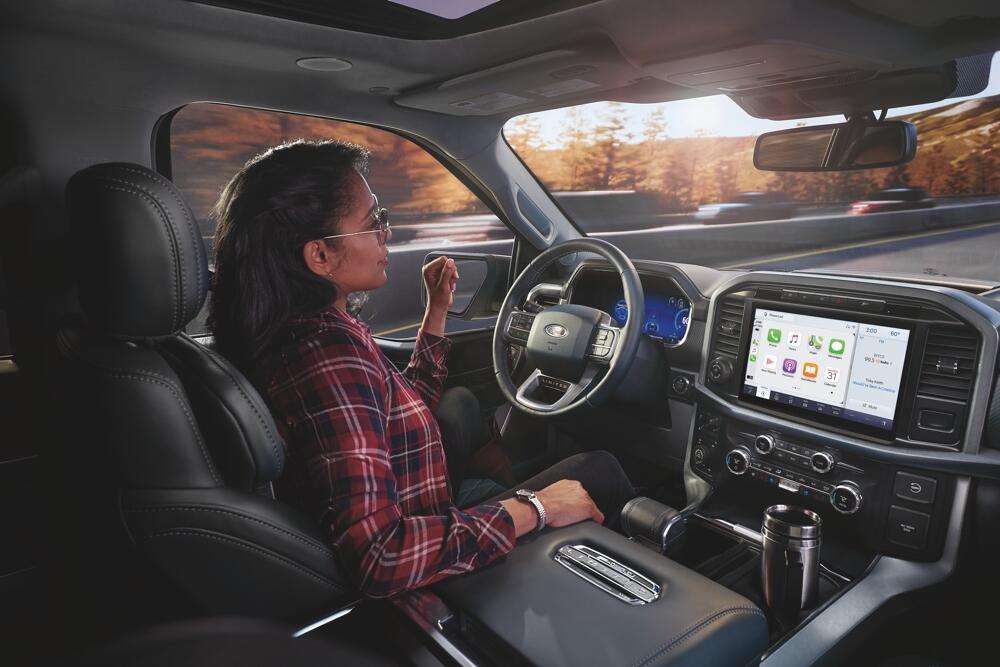
Ford's BlueCruise feature allows the driver to watch the road while the car steers.
Image: Ford Motor Company
The age of the self-driving car is still a few years away, but thanks to the efforts of Ford and General Motors — companies not usually considered to be cutting-edge technological powerhouses — the age of the hands-free driver begins in 2022. That's because the Ford F-150 and Chevrolet Silverado pickup trucks, which are two of the most popular vehicles in America, are both gaining the latest driver-assist tech for the 2022 model year.
I've driven them both, so here's the rundown.
BlueCruise is Ford's version, and I got the opportunity to test an almost-final release earlier this week in Los Angeles. The 405 freeway is the worst environment imaginable for a system that promises to handle speed and steering while the driver supervises, but BlueCruise worked as advertised.
When activated, BlueCruise handles steering while the adaptive cruise control system maintains your speed. Using radar sensors in the front grille and on all four corners of the car and a single wide-angle camera mounted high on the windshield, the vehicle can get a real-time view of the world around it.
SEE: Future of farming: AI, IoT, drones, and more (free PDF) (TechRepublic)
A highway is actually a pretty friendly place for an advanced driver-assist system like BlueCruise: All the cars are going the same direction (probably) and there isn't any cross-traffic (probably) and the lane lines are well-marked (probably). Assuming all those things are true, it's not too difficult for a car to maintain the appropriate speed and keep itself in its lane.
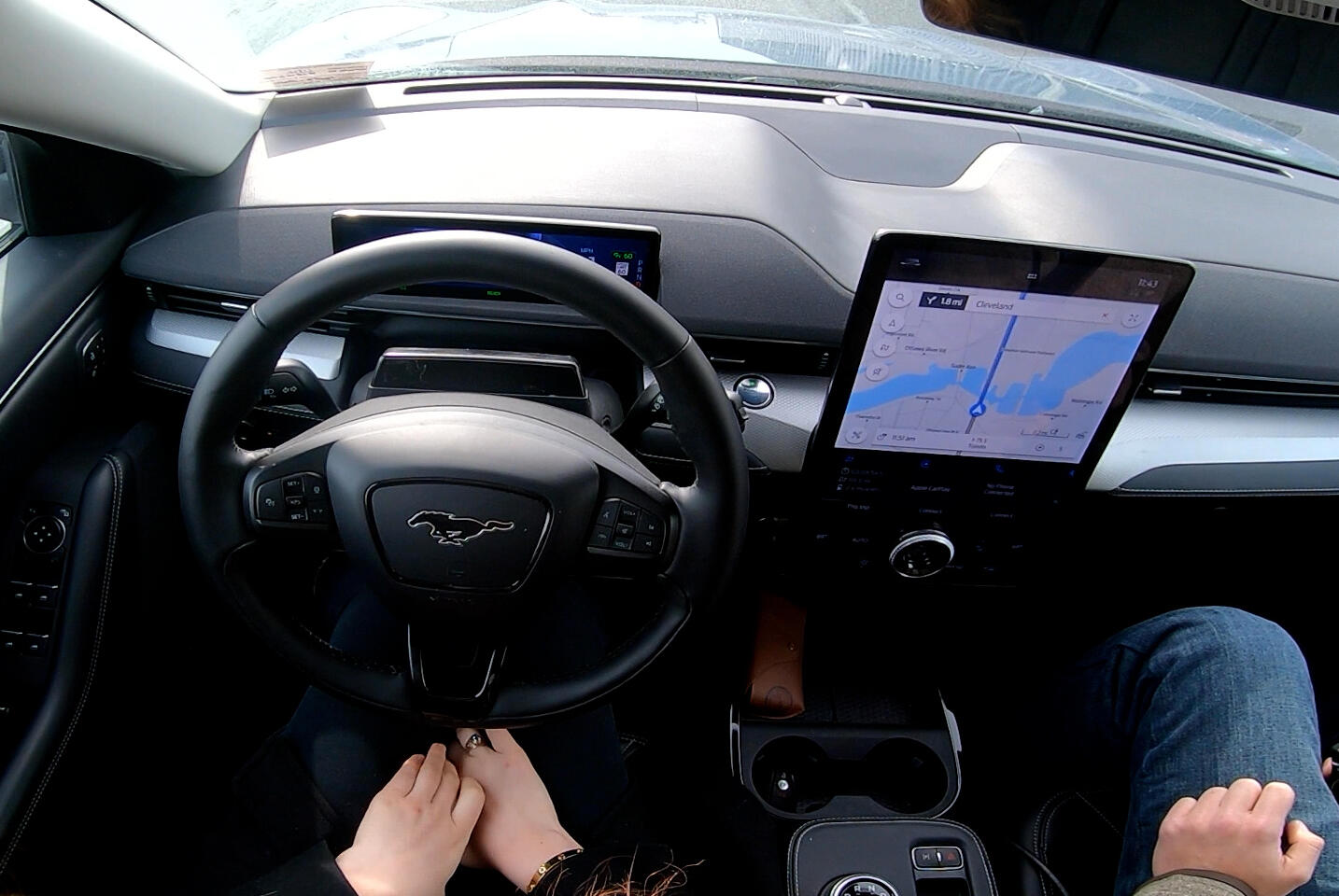
Ford's BlueCruise will be available in the Mustang Mach-E (pictured here) and the F-150 pickup.
Image: Ford Motor Company
And it works! I pulled a 2021 Ford F-150 onto the 405 and set the cruise control. Until now, this has been standard fare for the F-150 and the adaptive cruise maintained speed and kept me from running into the car in front of me.
Behind the scenes, a lot must happen before BlueCruise turns on:
- First, the car checks its current GPS location against a map of known "Blue Zones" to verify that it's safe to activate. If you aren't on a limited-access divided highway, for example, it won't turn on.
Once that's taken care of, the car checks to see if my hands are on the wheel and that I'm watching the road.
If all of the above is true, BlueCruise begins using the onboard camera to verify that the car is currently near the center of the lane.
Then, with a brilliant blue animation on the in-dash display, BlueCruise takes over, with me still overseeing proceedings.
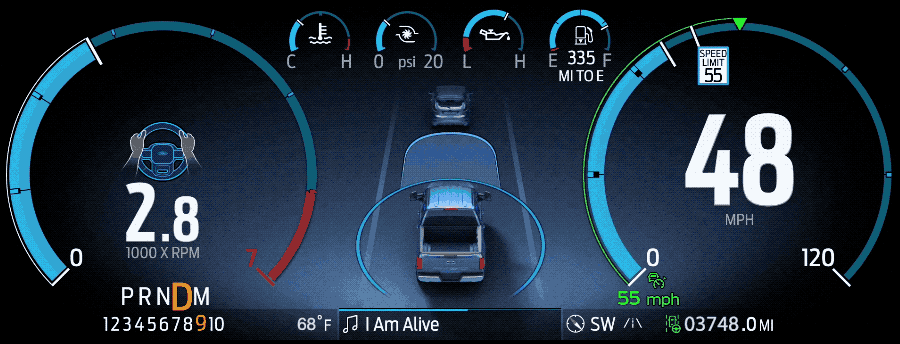
The animation on the Ford F-150 dashboard when BlueCruise activates.
Image: Ford Motor Company
It's just as important to know what BlueCruise is not as it is to know what it is.
Ford calls it a Level 2 advanced driver-assist feature, meaning it combines two driver assistants into one more advanced system: In this case, it combines an adaptive cruise with an advanced lane centering technology. In other words, the car steers itself while you supervise.
To ensure that you are paying attention, Ford has installed a driver monitoring camera that tracks both where your eyes are looking and where your head is pointing. Look away for too long — say, down at your phone or at your kids in the backseat — and the system starts with a warning before turning off entirely if you don't behave.
But if you keep a relaxed eye on the road, the system will happily keep you centered in your lane. I've used similar tech on long road trips in the past, and it significantly reduces the stress of long journeys.
Using BlueCruise, I can tell that it's a first-generation system. Though Ford is emphasizing the 500,000 miles of development testing that was performed, including a 110,000-mile "Mother of All Road Trips" to prove out the system, BlueCruise is still in its infancy.
It keeps the vehicle in the center of the lane, but with a little too much urgency. It's not a safety issue, but to a driver unfamiliar with what's going on, the steering movements are a little too frequent and a little too jerky. I can tell that the computer is working really hard to keep the car centered at all times — I compared it a 16-year old driver who was still learning the ropes and wasn't quite confident in their abilities, making frequent, jerky input adjustments as they drive along rather than smoother, more practiced inputs that an experienced driver would make.
It isn't necessary to always be centered exactly in the lane, after all — an experienced driver knows that drifting a few inches to the left or right is normal. I said to the Ford engineers that most people probably wouldn't notice the tiny steering inputs, but they might lose confidence in the system because of it, even if they couldn't quite put their finger on why. Future releases will improve on it, I'm sure.
BlueCruise also isn't (yet) aware of anything going on to the side or behind the vehicle. At one point in my test drive on the 405 — which is traffic-filled with narrow lanes — a semi-truck in the adjacent lane began crossing over the lane line from the right. I saw the move in progress and, though the truck probably wasn't going to hit us, it was getting alarmingly close. BlueCruise didn't warn me of impending disaster, nor did it attempt to edge away from the truck.
I asked Ford engineers about this, and they reiterated that the driver was ultimately responsible for the operation of the vehicle at all times but admitted that BlueCruise would not currently adjust its position in the lane based on vehicles coming in from the sides. Now, this is something that can be added in the future. It's likely that the vehicle's side-facing radar could detect the truck, but it was simply not programmed to react to it.
Other systems, including those from Mercedes and General Motors' Super Cruise, would have moved our vehicle away from the truck by a few inches to try to avoid a potential collision — but even those systems would never cross over the other lane line to move away. It would be up to the driver to make any changes so drastic as that.
General Motors spokesperson Patrick Sullivan told me that the latest version of Super Cruise, which debuts later this year, has "a dynamic offset feature that can sense the encroaching vehicle and move a small amount within the lane for improved driver comfort for mild encroachments" but only "within your lane."
BlueCruise also only uses the vision camera to determine its position in the lane, while Super Cruise also uses the car's "high precision GPS" (as well as its onboard camera) to place the vehicle in the lane.
It's also important to note that I have no concerns about the safety of BlueCruise. Still, Super Cruise is a more mature product and includes a handful of additional features that are important for buyers to be aware of. Ford told me that BlueCruise would receive multiple feature and iterative improvements every year.
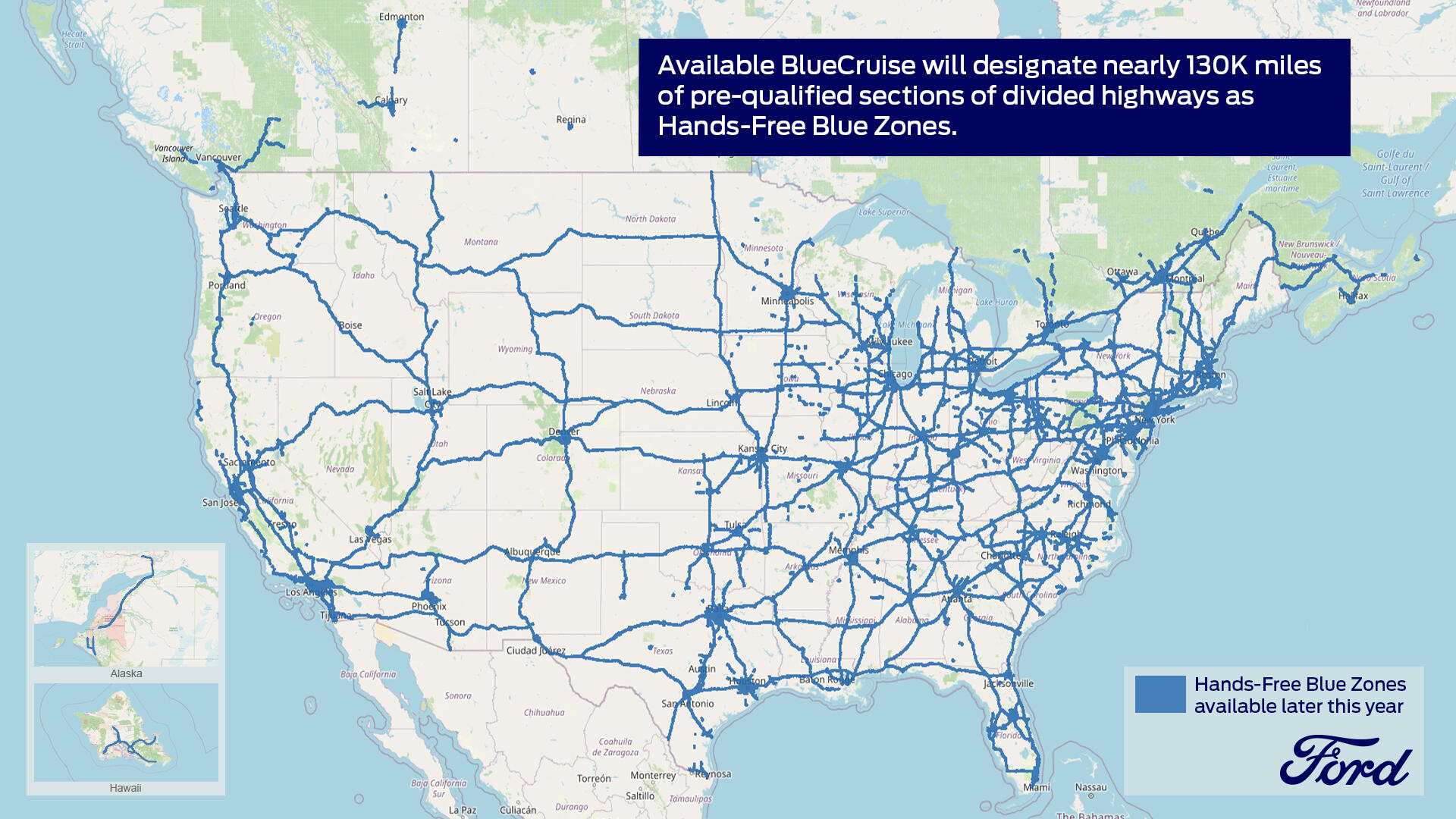
A map of "Blue Zones" where Ford's BlueCruise will work.
Image: Ford Motor Company
BlueCruise works on nearly 130,000 miles of divided highway in the US and Canada, with just about all of the interstate highway system supported and a lot of state highways. It'll make its public debut in the next few months, first in 2022 Ford F-150 and Mustang Mach-E models and then properly equipped 2021 F-150 and Mach-E vehicles as an over-the-air update.
On the F-150, buyers will need to add the Ford Co-Pilot 360 Active 2.0 package (standard on the F-150 Limited and available for $1,595 on Lariat, King Ranch and Platinum).
The Mustang Mach-E electric car includes BlueCruise standard on the California Route 1, Premium and First Edition trims, and it's available as a $3,200 option on the Select Trim (which also adds a 360-degree camera, heated front seats and a heated steering wheel).
The packages in both cars include the hardware and three years of over-the-air software updates to keep the system working and new capabilities coming. Keeping the service after three years will cost more, but Ford has said the subscription would follow the VIN of the car — that means if you sell your BlueCruise-equipped Mach E after two years, the buyer will still get the third year of BlueCruise.
Pricing for the system after the third year was not shared, but Ford has mentioned several BlueCruise features that will be coming in the future:
Lane Change Assist will have the vehicle change lanes itself after the driver uses the turn signal to initiate the change.
Predictive Speed Assist will allow the car to automatically slow for curves in the road, roundabouts and more.
Thousands of miles of new BlueCruise-approved roadways and updates to the system as roads change over time.
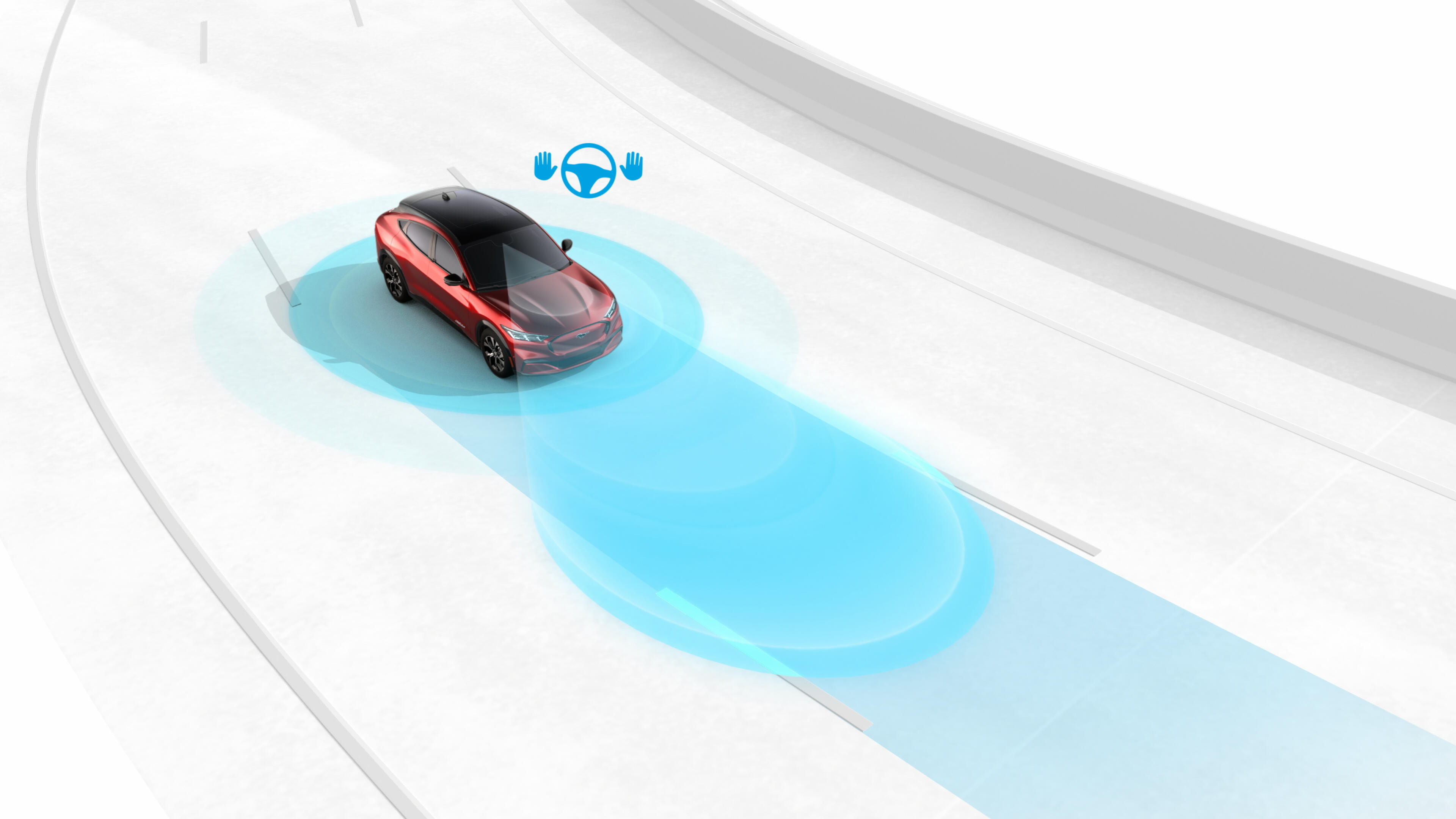
An illustration of the Ford BlueCruise technology.
Image: Ford Motor Company
Ford says that it expects to sell more than 100,000 BlueCruise equipped vehicles in its first year of availability. Curiously for a car company press release, Ford specifically mentioned a few competitors by name when talking about BlueCruise.
It compared the tech to Tesla's Autopilot but added that BlueCruise had "the advantage of offering a true hands-free driving experience while in Hands-Free Mode that does not require a driver's hands to stay in contact with the steering wheel unless prompted by vehicle alerts."
It also mentioned GM's Super Cruise, which uses a red or green light strip on top of the steering wheel to inform the driver of the system's current status. Ford noted that BlueCruise uses the text and blue lighting cues in the instrument cluster to communicate with the driver, making the system "effective even for those with color blindness."
Sullivan, the GM spokesperson, noted to me that the Super Cruise light bar also blinks at different frequencies depending on the color and message being sent: "Green is solid, blue is a slow pulse, and red is a quicker blink." Green means the system is in operation, blue means the driver has taken control momentarily to change lanes, while red means the system is deactivating, and the driver must resume control immediately.
One thing that Super Cruise does that Ford doesn't is to give audible cues that the system is activating or deactivating. Ford's system only provides audible tones when the driver needs to take over unexpectedly or when the driver looks away for too long.
In addition to those two examples, Super Cruise also makes an audible tone when the system is first engaging or when disengaging due to user input (like touching the brake pedal or turning off Super Cruise with a button on the steering wheel). It's easy to tell, both from the visual cues and from the auditory ones, what is going on.
Ford seemed interested in this particular bit of feedback from me, and I got the feeling that they might explore this potential feature more.
BlueCruise should make its public debut in the next few months, and I'll be testing it much more once it does.

A preproduction 2022 GMC Sierra testing Super Cruise while towing.
Image: GMC
As for Super Cruise, the Chevy Silverado (and its corporate brethren, the GMC Sierra) is gaining a new, updated version for 2022. Super Cruise has been around for a few years but only in a handful of Cadillac models, including the 2021 Escalade (which will be getting this update over the air later this year).
The new version of Super Cruise adds to the system's already impressive feature set, with the addition of Super Cruise while towing and fully automatic lane changes. The former is easy to understand, while the latter is fascinating and exciting.
In a controlled demonstration on the 4.5-mile circular test track at GM's Milford Proving Ground, I got to test out the new Super Cruise in a near-final but pre-production GMC Sierra pickup truck. As promised, the system would accelerate to the set speed while keeping us centered in our lane without me putting my hands on the wheel — I just had to keep my eyes on the road because, as with Ford's BlueCruise, cameras were watching to make sure I was paying attention.
But when a vehicle was going below our set speed in our lane, the truck used its long-range rear-facing radar to determine if the passing lane was clear. Then — with absolutely no input from me — the truck signaled, changed lanes, and then passed the slower vehicle in front of us. With that complete, it signaled again and moved back over to the original lane.
Now, Tesla has offered similar capabilities with AutoPilot for a while, but it's particularly impressive to see this sort of driver-assist tech coming from the legacy automakers. And more excitingly, it's coming in the best-selling vehicles in the country. Millions of people have never seen Tesla Autopilot in the real world and millions more who would never consider buying one.
With BlueCruise and Super Cruise coming to the country's best-selling vehicles for 2022, it's opening up a whole new audience to these cutting-edge systems. And, considering how far some pickup truck owners drive regularly, they might be the best test case yet for these almost-but-not-quite self-driving vehicles.

Tech News You Can Use Newsletter
We deliver the top business tech news stories about the companies, the people, and the products revolutionizing the planet. Delivered Daily
Sign up todayAlso see
- DevOps: A cheat sheet (TechRepublic)
- C++ programming language: How it became the foundation for everything, and what's next (free PDF) (TechRepublic)
- Video game career snapshot: Industry insights and jobs for IT pros (TechRepublic Premium)
- Tom Merritt's Top 5 series (TechRepublic on Flipboard)







 English (US) ·
English (US) ·